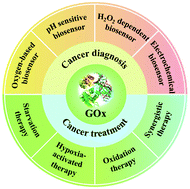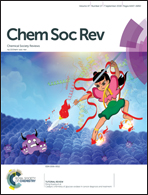Catalytic chemistry of glucose oxidase in cancer diagnosis and treatment
Abstract
Glucose oxidase (GOx) is an endogenous oxido-reductase that is widely distributed in living organisms. Over recent years, GOx has attracted increasing interest in the biomedical field due to its inherent biocompatibility, non-toxicity, and unique catalysis against β-D-glucose. GOx efficiently catalyzes the oxidization of glucose into gluconic acid and hydrogen peroxide (H2O2), which can be employed by various biosensors for the detection of cancer biomarkers. Various cancer therapeutic strategies have also been developed based on the catalytic chemistry of GOx: (1) the consumption of glucose provides an alternative strategy for cancer-starvation therapy; (2) the consumption of oxygen increases tumor hypoxia, which can be harnessed for hypoxia-activated therapy; (3) the generation of gluconic acid enhances the acidity of the tumor microenvironment, which can trigger pH-responsive drug release; (4) the generation of H2O2 increases the levels of tumor oxidative stress, and the H2O2 can be converted into toxic hydroxyl radicals that can kill cancer cells upon exposure to light irradiation or via the Fenton reaction. More importantly, GOx can be combined with other enzymes, hypoxia-activated prodrugs, photosensitizers or Fenton's reagents, to generate multi-modal synergistic cancer therapies based on cancer starvation therapy, hypoxia-activated therapy, oxidation therapy, photodynamic therapy, and/or photothermal therapy. Such multi-modal approaches are anticipated to exert a stronger therapeutic effect than one therapeutic mode alone. Thus, maximizing the potential of GOx in a biomedical context will offer novel clinical solutions to diagnose and treat cancer. In this tutorial review, we introduce the recent advances of GOx in cancer diagnosis and treatment. We then emphasize the design principles and biomedical applications of GOx-based biosensors and cancer therapeutic approaches. Finally, we discuss the challenges and future prospects of GOx-based catalytic systems in biomedicine.



 Please wait while we load your content...
Please wait while we load your content...